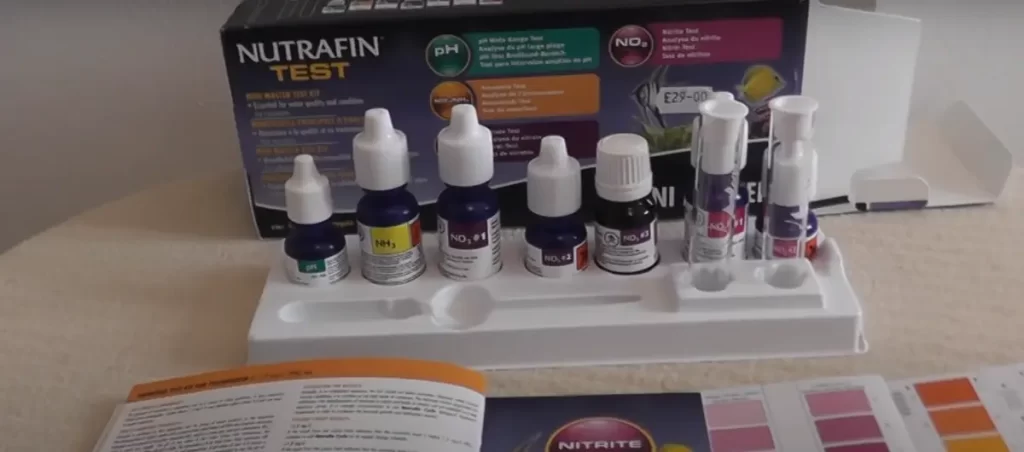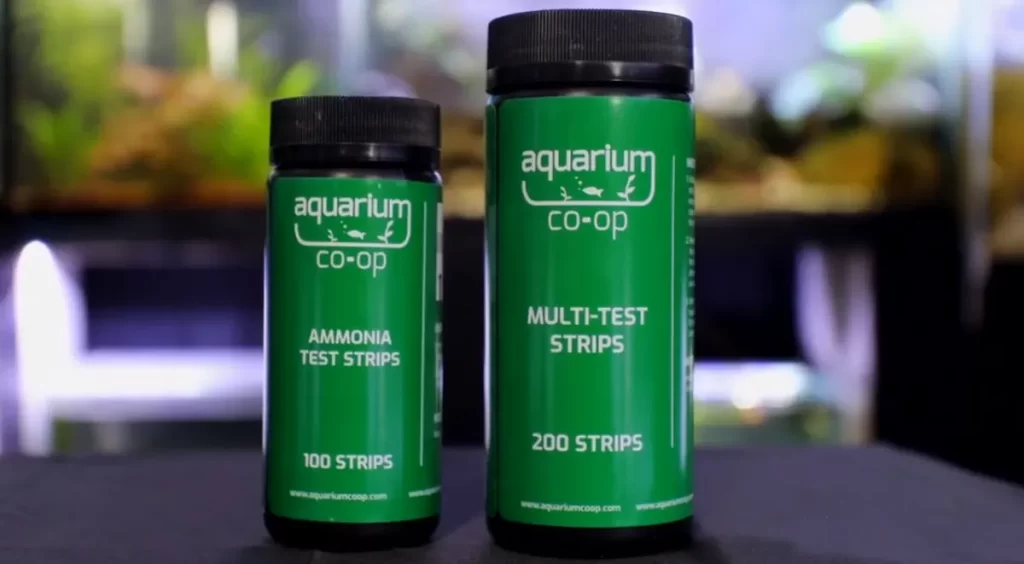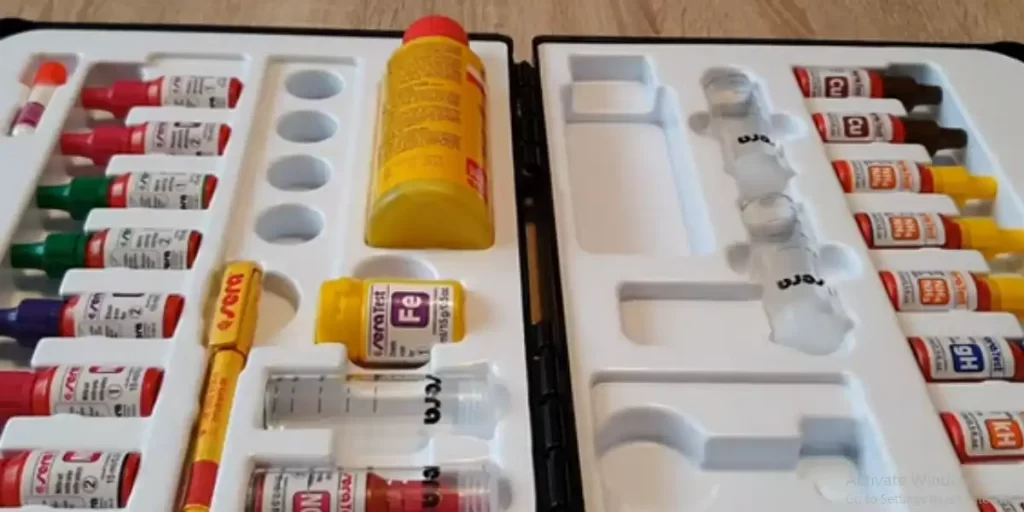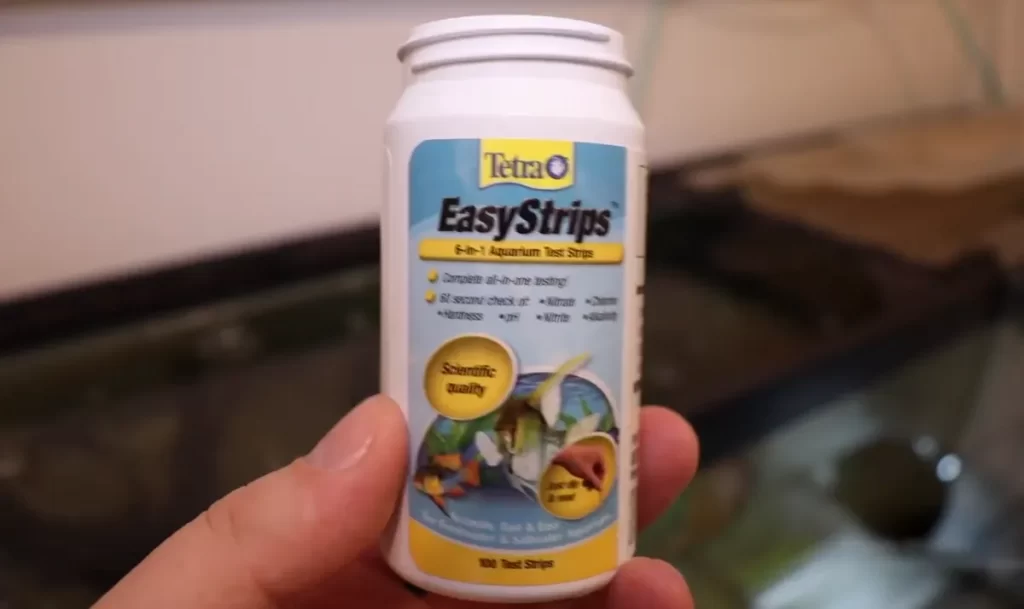Affiliate Disclaimer:
FishKeepingAnswers.com is reader-supported. When you buy through links on our site we may earn a commission.
It always amazes me that we can keep a glass box in our homes, filled with water and a myriad of living fish, invertebrates, and plants. Even after all these years in the hobby, I get tremendous enjoyment even from some of the simplest aquarium setups.
One reason we are able to keep fish and plants alive is thanks to our understanding of water parameters and water chemistry. Even if we only have a very basic comprehension of how and why these things work, we all know they do. Filter the tank, change a small amount of water regularly and all will be well.
Sometimes however we need a way to check exactly what is going on in our water. We all know how to check the temperature of the water, but measuring the pH, nitrate levels, or general hardness of the water can be a little more tricky. Thankfully, that is what aquarium test kits are for.
Why Do We Need To Test Our Aquarium Water?
Testing our aquarium water is an essential part of maintaining a healthy, closed system. Typically in our aquariums, we have fish, plants, shrimp, and snails from all over the world, none of which would live together naturally, and never would they occur in such high concentrations in the wild.
In the wild, fish like Neon Tetras live in groups of many tens of thousands of fish, however, they live in vast river systems that contain millions upon millions of gallons of water. In our aquariums, we might keep 100 or more fish in only 125-gallons (475 liters). The stocking levels are way over what might occur in nature.
Although we use filters to keep our aquarium water clean, the filter can only do so much. It can’t for instance change the pH or reduce the amount of nitrate in the water. To do those things we need to change some of the water, and testing helps us know when to carry out those water changes.
Testing is also a crucial part of setting up a new tank. When an aquarium is set up for the first time we need to cycle the aquarium. Cycling is simply the process of allowing beneficial bacteria to build up to levels where the filter can successfully process the waste from the fish.
Testing the water of a newly set up aquarium on a regular basis helps us know when the aquarium cycle has started and how it is progressing.
How Often Should We Test Our Aquarium Water?
The question of how often we should test aquarium water is one that is hotly debated across the internet. On fish-keeping forums, members will battle one another over how often testing should be carried out. You typically get some fish keepers who never test their water and others who will test religiously every few days.
In my own fish room, where I have a lot of aquariums, I typically test based on need. The newer the aquarium is set up, the more frequently I will test the water.
As a general rule, I would suggest that a home hobbyist with one or two aquariums in their care should test their aquarium water about once a month unless they believe there is something bad happening in the water. If the fish are acting weird or you have fish or shrimp dying unexpectedly, the first thing I would recommend is for people to test their water.
Testing a newly set up aquarium
If you have a newly set up aquarium, you will want to test the water on a more regular basis. Testing a new aquarium helps us work out how the aquarium cycle is progressing.
When we start a new tank, there will be almost no beneficial bacteria present to process fish waste. This is why we can’t just fill a new tank with water and then throw the fish in. The bacteria are naturally occurring, but it does take time for their numbers to increase.
In my experience, the best way to set up a new aquarium is to fill it with water and then add some live plants to kick start the cycle. Live plants help jump-start the cycle. If you don’t plan on using live plants in your new aquarium, adding just one or two small fish will also get the cycle started.
It is then really important to test your water every day for the first few days. You would expect the water to register high ammonia levels for the first few days, then, as these levels drop, the nitrite levels will increase before they too drop and the nitrate levels go up. When you see nitrate, you know your aquarium is cycled as nitrate can only show on a test when beneficial bacteria is present
What Should We Test Our Aquarium Water For?
Modern test kits can measure a wide range of different water parameters. Some liquid kits and test strips measure for just the basics, however, other test kits measure for quite specific chemicals or impurities.
The parameters we can measure include;
Truth be told, I have never tested my aquariums for half of the things listed above. In fact, many of the test kits that measure parameters like zinc or magnesium are designed for saltwater aquariums where people keep highly sensitive corals.
In the freshwater fishkeeping hobby, the main tests we tend to carry out are ammonia, nitrite, nitrate, and pH. Sometimes we will also test for hardness, but typically this doesn’t change much over time, so frequent testing is not required.

Ammonia
Ammonia is a byproduct caused either when fish go to the bathroom or when uneaten food left in the water column begins to break down. Decaying dead fish and plant leaves can also cause ammonia levels to rise. Ammonia is highly toxic to fish, and even at relatively low levels can cause fish to die or become susceptible to pests and diseases due to stress.
We typically see high ammonia levels in aquariums that are newly set up, or where additional fish have been added to an aquarium in a short space of time. This is called an ammonia spike. Ammonia spikes are normally short-lived but can be fatal to the fish population.
Our aim should be to keep ammonia levels at 0ppm (parts per million) once the aquarium is fully cycled.
Nitrite
Nitrite is the next step in the nitrogen cycle. When the beneficial bacteria in our filters process ammonia, as a byproduct they create nitrite. Nitrite is less toxic to our fish, but can still cause our fish to become unwell or even die.
By measuring nitrite levels, we can tell our aquariums have begun to cycle and will soon be ready to receive fish. Generally speaking, we want nitrite levels to be at 0ppm once the aquarium is fully cycled.

Nitrates
Nitrates are the final stage of the nitrogen cycle. Once nitrates begin to show we know the nitrogen cycle is complete and our aquarium is fully cycled.
Nitrates are far less toxic than both ammonia and nitrite, but only to a certain point. Fish can tolerate relatively high levels of nitrates, however at a certain point fish may begin to suffer.
Typically we want the nitrate levels to stay at 40ppm or lower. With that said, many of the hardier species of fish can easily tolerate 100ppm of nitrate.
pH
pH is the measure of how acidic or alkaline our aquarium water is. Some fish, like wild Discus, want their aquarium pH to be lower, around 6.5, whereas many African Cichlids want the pH of their aquarium water to be high, around 8.0 to 8.5 is ideal.
For many of us, the pH of our aquarium is dictated by our tap water. If we have tap water that has a low pH, it is relatively easy to raise that pH up, but it is not so easy to do it the other way round.
Chlorine (or Chloramine)
Chlorine is added to our tap water by the water board to make out water safe to drink. Unfortunately, chlorine is toxic to fish and will burn their gills. We can remove chlorine by using a water conditioner. It can be useful to test for chlorine in the water before adding it to our tanks.
How Do We Test Our Aquarium Water?
There are primarily two different ways we can test our aquariums, liquid test kits or test strips. In my experience, both have their place and I use both types in my own fish room. Typically I find liquid test kits to be more accurate, but test strips are better for quick testing or testing a large number of tanks in one go.
Liquid Test Kits
Generally speaking, liquid test kits are more accurate than test strips. Typically, to use a liquid test kit you will fill a vial with a set amount of water, and then add a defined number of drops off whichever chemical the test company has supplied.

For some liquid test kits, the results are based on the color of the liquid after 60 seconds. For others, it’s the number of drops it takes for the vial of water to change from one color to another.
I have had good success using the API Master Test Kit, which tests for various different parameters. With this kit you leave each vial for 5 minutes, then compare the color of the vial of water to a test card.
Test Strips
Liquid test kits are fantastic if you only have one or two tanks to test. When you have multiple tanks that require testing, or you need to test quickly, test strips are the answer.
Typically, to use a test strip you dip the whole strip into the aquarium for a second or two, then leave the strip for 60 seconds. The test strips have multiple pads along their length, each of which measures a different parameter. After 60 seconds have passed you compare the test strip to a card and work out from there the reading for each parameter.

In my experience, whilst test strips are quicker to use than liquid test kits, they are typically not as accurate. I haven’t found this to be a major problem. I usually don’t need an exact reading, I just need to know if a particular parameter is higher or lower than it should be.
There are many different strip test kits on the market. I have used many over the years. Below I look at some of them in more detail.
Are Test Kits Accurate?
In my time as a fish keeper, I have used multiple different test kits, and I have to say on the whole they are pretty accurate. For most of us, we do not need to know the exact level our nitrates or ammonia are at, we just need to know, are they present, and if they are, are they too high.
I would say test kits are as accurate as they need to be. If for some reason you need to know the exact level an individual parameter is at, you can purchase scientific-grade test kits, although I have never found the need.
Which Test Kits Are Best?
Determining which test kit is the best can be tricky as some people value accuracy while others are looking for convenience. Below I look at some of the most popular brands on the market, each of which I have used at one point or another.
By weighing the pros and cons of each brand we can determine which test kit best suits our needs.
API Master Test Kit

The API Freshwater Master Test Kit is probably the best-selling liquid test kit on the market. This is a test kit I personally have been using for around 5 years now, and I have always found it to be fairly accurate.
The API Freshwater Master Test Kit measures the following parameters:
This test kit includes all the chemicals required to carry out the five different tests, as well as 4 glass vials, and a plastic test card allowing you to compare the results and decide the readings.
I have found the API Test Kit is one I use when I have time on my side. Sometimes I will test my aquariums for the pleasure of seeing how they are doing. Testing with this kit can be slow. To test for nitrates for example you have to add 8 drops, then shake the vial, then add 8 drops of a second chemical, then shake the vial again, then leave to stand for 5 minutes before reading the results.
If you have just one or two tanks to test, this kit is ideal. If you have a whole fish room filled with aquariums, this kit can be a little slow going.
This test kit is a little spendy, costing around $30, but it does last for a long time. API themselves say you can carry out around 120 tests using this test kit. I have had the same box of tests for around 3 years, and it is still going strong.
I have met fellow aquarists at fish clubs who claim they have not found this test kit to be reliable, but I haven’t found this to be a problem. The API Master Test Kit does require the user to be fairly accurate otherwise the results can be skewed.
Nutrafin Master Test Kit

The Nutrafin Master Test Kit is another liquid test kit that I have used many times over the last couple of years. Whilst like the API Master Test Kit above, this kit tests for ammonia, nitrite, nitrate, and pH, it also allows us to test for calcium, phosphate, iron, KH, and GH.
It is fair to say this is a more comprehensive test kit than the aforementioned API test kit, however, it does not seem to be as popular, and that is probably down to the cost. From memory, I paid over $100 for my Nutratifn test kit, which still represents fairly good value, but does obviously require a serious upfront investment.
In my experience, this test kit has proved to be more accurate than the API Master Test Kit. This kit allows us to test for;
This test kit also comes with 5 glass test tubes and two pipettes. I also like the fact this whole kit comes in a rigid plastic case, helping keep everything in one place until I need it.
From talking with other fish keepers who also use this test kit, it seems results can be variable if you don’t follow the instructions. I have never found there to be a problem, but I know others have complained about not getting the results they were expecting.
Aquarium Co-op Test Strips

The Aquarium Co-op Test Strips have been specially developed by Cory from Aquarium Co-op. Cory is a true aquarist and he developed these test strips to be as accurate as can be.
These strips come in two different forms, one is a multi-test strip and the other is just for measuring ammonia. I believe they were developed as two separate test strips because the chemical on the pad that makes the ammonia test strip work would react with the chemicals on the other test pads.
The multi-test strip measures the following parameters;
I have found these test strips to be the most accurate test strips on the market. To test your aquarium water with these test strips you simply dip one test strip into your aquarium water and remove it after a second or two. Once you have removed the test strip from the water you wait 60 seconds before comparing the strip to the laminated card that comes in the box.
In my experience, the color on the test card does relate well to the actual test strip, which isn’t the case with all test strips.
The Aquarium Co-op test kit has 200 test strips in the box, which I believe is the most of any of the test strips on the market.
The Aquarium Co-op Ammonia Test Strips only need to be left for 30 seconds after you remove them from the aquarium water before comparing them to the color chart. The Ammonia Test Strips have 100 strips in the box.
The only place I have found to buy these test strips is directly from the Aquarium Co-op website, but I have always found their delivery to be very fast and their customer service is top-notch.
The Aquarium Co-op test strips work out to less than $0.09 per test strip, which is one of the most economical test strips on the market.
API 5-in-1 Test Strips

These test strips from API cover the 5 basic parameters we need to measure. I have found these test strips useful when I am cycling a new aquarium. To see how far your cycle has come you only really need to measure nitrite and nitrate, so these have you covered.
Much like other test strips, these ones just need dipping into the aquarium for a second or two, then compared against the color guide which is printed on the back of the bottle.
There are 100 test strips in the API 5-in-1 Test Strips tube and they can be used to measure;
Much like the Aquarium Co-op test strips, these test strips do not test for ammonia. If you want to test for the presents of ammonia in your aquarium water you will need to buy a pack of API Ammonia Test Strips.
When using these test strips, if you are measuring General Hardness or Carbonate Hardness you need to compare the color of the test immediately, however, if you are measuring pH, nitrite, or nitrate you need to leave the strip for 30 seconds before comparing the colors.
These test strips work out at less than $0.25 per test, so they are fairly economical to use.
Sera Aqua-Test Box Aquarium Test Kits

The Sera Aqua-Test Box Aquarium Test Kit is generally considered to be the gold standard of liquid test kits. Not only is the Sera Test Kit known for its accuracy, but it also covers 10 different water parameters.
I was lucky enough to be gifted one of these test kits a couple of years ago, which I was really pleased about because they cost close to $100 a kit.
The Sera Aqua-Test Box (+ Cl) Aquarium Test Kit contains tests for all the following;
In my opinion, the Sera Aqua-Test Box Aquarium Test Kit is probably the best one on the market, if you can stomach the purchase price. I think it is fair to say nothing comes close in terms of accuracy.
One other thing I must compliment Sera on with this test kit is the color comparison chart. Rather than being a tiny card, you get a decent-sized chart, making it easier to accurately compare the color in the test tube with that on the chart.
I have read others complain that the instructions in this test do not distinguish between chlorine and chloramine, but in my experience, it clearly reads both. I have chloramine in my current fish room and regular chlorine in my previous fish room. This kit registered both.
To me, this is a nicely laid out test kit that can be stored in its own hard carry case. The instructions are a little hard to read, and this may not be a kit for the first-time fish keeper, but it is essentially a great kit, especially for those who take their fish keeping seriously.
Tetra Easy Test Strips

The last aquarium test kit on my list is the Easy Test Strips made by Tetra. Tetra has been a staple manufacturer in the hobby for many years, and in my opinion, is one of the finest fish food manufacturers. I have found these test strips from Tetra to be fairly good. They get a lot of stick from some fish keepers, but I have always got on ok with them.
The Tetra Easy Test Strips come in a pack of 100 for just under $20, which means each test costs just less than $0.20 each. For me, this is not too bad but does work out about twice the cost of using an Aquarium Co-op test strip.
These test strips can measure;
Much like other test strips, these ones just need to be dipped into the aquarium for a second or two before leaving for between 10 and 60 seconds (depending on which test you are carrying out), then comparing the test strip to the color card.
So Which Test Kit is the Best?
I have used all of the test kits listed above. All of them do the job. Some are simple to use, and others have proved to be more complex.
To decide which one is best we need to establish why we are testing the water. In my own fish room, I generally use test strips because they give me a quick reading that is good enough to work out if something is going wrong. I can quickly dip 20 test strips into 20 tanks, and after a minute or two quickly go back checking each one for any obvious issues.
On the other hand, when I recently set up a new Discus display tank that housed nearly $1,000 worth of Discus, I needed to monitor the water quality carefully and accurately for a number of weeks, and when I did I used a liquid test kit.
To conclude I would like to give two recommendations, one for a liquid kit and one for a test strip.
For a liquid kit, I would always recommend the API Master Test Kit. Whilst you can’t beat the Sera kit for accuracy, the cost just puts it out of reach of the average fish keeper. If you own just one or two tanks with a general community setup, you are unlikely to want to spend $100 on a test kit.
The API Master Test Kit provides everything the regular fish keeper would want to test for, and it is fairly accurate. The API kit is not without its faults. The test tubes for instance are so thin I knock them over almost every time, but that’s because I am clumsy.
As for a test strip, I would have to recommend the Aquarium Co-op Test Strips. Not only do you get twice as many test strips in every tub, but they seem to be the most accurate test strip on the market. Plus, at less than $0.09 a test, they are within the reach of pretty much every fish keeper. No one is going to think twice about spending so little to test their aquarium water.
If there is an option to buy both a liquid test kit and strips, get them both. That way, when you are in a hurry and need a quick result, go for the test strips. When time is on your side and you want to get an accurate picture of what is going on with your water, reach for the liquid test kit.





